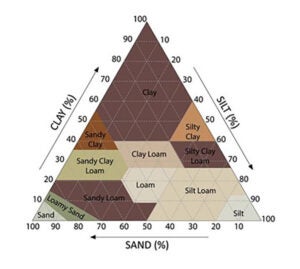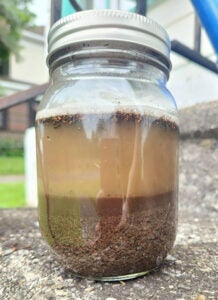The weather is nice, gardens are blooming, some of our front porch flowers have tried to die (I’m talking about you, pansies!), so surely soil has been on your mind a few times this year!
If you’ve ever wondered why some fields are much wetter or drier than others, or why some fields of corn survive a drought better than others, it’s partly because there are different types of soil involved.
The three major categories of soil are sand, silt and clay. Soil can be made up of one of these, or all of them. They each have unique and important properties to them, and the U.S. Department of Agriculture even breaks this down in 12 smaller classifications of soils.
- Of the three major categories, sand has the largest particle size. Sand is very well draining because it allows for air and water to flow between the particles. When you think of a sandy soil, you can think of a ball pit full of big yoga balls!
- Silt particles are smaller than sand, but larger than clay. Silt is easily washed or blown away. It holds water well but still dries out nicely. Silt often makes for very good agricultural land. When thinking of silty soil, imagine a ball pit filled with basketballs, lots of space, but not too airy!
- Finally, clay is the smallest particle size of soil. It has excellent water retaining ability, sometimes too much! Clay is very heavy and sticky, making it a hard medium for roots to push through. Going back to the ball pit, clay is like a pit full of marbles, very little space for air.
Knowing what type of soil you have in your fields is important come planting season. If you have a field that always gets planted last because it’s wet longer than the others, it is likely high in clay. But the field you rush to first every year probably has more sand since it dries out early.
If you don’t take soil samples, that’s not a problem at all! It’s easy to know what type of soil is in your field, all you need is a jar, soil, and water.
To see what percentage of sand, silt, and clay you have in your soil, fill a glass jar (with a lid) about a third with soil. Fill it with water, leaving some room at the top. Now shake the jar well for about two minutes. After that, set the jar aside to settle.
After all the soil has settled and the water looks clear again, you can clearly see some layers in the soil. The bottom layer will be your heaviest particles — the sand. The middle layer is silt, and the top layer is clay. Use this chart below to determine what type of soil you have!

Take my jar below as an example, I have about 20 percent clay, so I put my finger on the 20 percent of the clay side of the triangle. I have about 50 percent sand, so I follow the 20 percent clay line over until I meet the line that goes up from the 50 percent sand. The chart says that I have sandy loam soil in my yard!
Loam is a combination of sand, silt and clay, and it is generally an ideal composition. Loam basically means mixture, so a sandy loam is a mixture that’s high in sand.

Now that you know what type of soil you have, what does it mean?
If you have a garden that doesn’t want to grow, you should conduct this test on your soil to see if you need to adjust your watering habits or add in a new medium to the soil to help with drainage or water retention. If you’re planting acres of crops, you should use this test to help you determine which fields you will be able to plant first. Being better organized in the planter will save you a lot of time and miles!
Soil is a complicated living organism, and it’s easy to forget to check on it and take care of it! Our farming practices can change the makeup of the soil. Because silt is so easily blown or washed away, you need to reduce tilling to your high silt soils.
Many livestock farmers utilize sand for bedding and traction on the floor, but remember, when you spread manure you’re adding sand to your soil composition.
It’s important to think about our soil and test regularly!
Do you want more information on soil sampling and soil types? Check out Michigan State University’s soil sampling guide. Most every state will have soil labs in their land grant university, so call your local extension office to ask about where to send in soil samples. And when you get soil samples back, check out this article by DeKalb or this one by Purdue University on how to read your results!
Elizabeth Maslyn is a born-and-raised dairy farmer from Upstate New York. Her passion for agriculture has driven her to share the stories of farmers with all consumers, and promote agriculture in everything she does. She works hard to increase food literacy in her community, and wants to share the stories of her local farmers.



